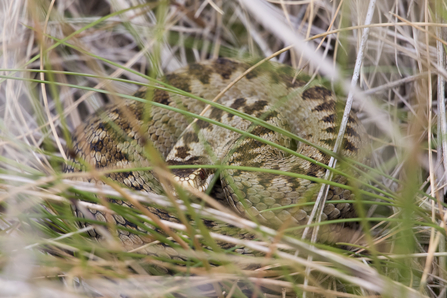
© Jamie Hall
Recovering Adders on the Cotswold Escarpment
The UK’s only venomous snake, the adder is an often misunderstood but wonderful species that have sadly been in huge decline across the country and now have protected status. The Recovering Adders project is focusing on enhancing habitat for these enigmatic reptiles who call the grasslands and woodlands of the Cotswolds home.
In September 2023 this project, along with the Frome Native Crayfish Recovery Project, was awarded funding from Natural England's Species Recovery Programme, aimed at ensuring the future of some of our most endangered species. Adders are protected in the UK, but still face threats from habitat loss, disturbance, fragmentation, and predation. Gloucestershire is one of few remaining strongholds for adders, and our neighbouring counties have already lost this amazing species.

© Chris Lawrence
This project will work with neighbouring landowners in the Cotswold Escarpment Nature Recovery Zone to improve suitable habitats and connectivity for adders, using management techniques such as scrub control and hedgerow planting, as well as making brash and log piles.
Frequently Asked Questions
Will the project have an impact beyond adders?
Natural England’s Species Recovery Programme is enabling us to not only recover high-priority species, it’s allowing us to do this at a landscape scale in the Cotswolds. We’re not just focusing on individual populations, but how these populations can be extended and enhanced across the landscape. This is great for adders, but also for a wealth of other species who will benefit from this vital work, creating habitat for other reptiles, amphibians, birds, and butterflies.
What habitat work will you be doing?
We will be planting hedgerows to reduce strong winds in basking areas, and fencing to control suitable conservation grazing and prevent over-grazing. Tree felling will open up areas of dense canopy and provide suitable places for adders to bask, paired with coppicing and scrub control, which will create 'soft edge' habitat, one that gradually transitions from one habitat to another. Creating cover with brash and log piles will provide areas where adders can hide from disturbance and predators, and create hibernation sites. Adders also sometimes use wetter areas around ponds, with more humid conditions during times of prolonged dry weather in the summer, so this project will also include pond creation.
Will GWT be translocating adders?
Translocations are an option for establishing new populations. However, in regions like Gloucestershire where there are widespread ongoing declines, priority should be to attempt to halt declines and promote the recovery of existing populations, rather than to direct resources to establishing further populations.
What do adders eat?
Adders hunt lizards and small mammals, as well as ground-nesting birds, such as skylark and meadow pipit. Adders' venom is used when hunting, to immobilise and kill their prey before eating it.
Why do adders bask?
Adders, like many other reptiles, need to bask in the sun for long periods of time to raise their temperature, they can't generate their own body heat like we can, making them ectothermic. They need to raise their temperature to build up energy which is essential for catching prey and mating. It is particularly important for males to bask in the sun after hibernation, before they 'dance' to compete for a mate, and after this point females need to bask to incubate their eggs internally, before giving birth to live young in late summer.
What habitat do adders require?
South-facing slopes or varied topography, diverse plant life with open areas and cover, habitat edges, habitat connectivity, abundant prey, and access to safe sites for hibernation. These factors provide suitable basking sites as well as places to hide, and ensure adders can gain enough energy to survive.
How can I help adders?
To help protect this endangered species, and prevent an accident, please avoid disturbing adders and keep your dog on a lead. If you spot an adder - or any other species - you can report your sighting to the Gloucestershire Centre for Environmental Records (GCER). This will add to the growing database of information about wild plants, animals and habitats in Gloucestershire, underpinning the evidence which Gloucestershire Wildlife Trust needs in order to prioritise and carry out its important conservation work.
By stopping and reversing wildlife declines in Gloucestershire before 2030, we hope to help this stronghold for adders, as well as the other endangered species that call this county home. By supporting our work or getting involved, you can contribute to safeguarding Gloucestershire’s vulnerable wildlife and wild places.
Are adders dangerous?
Adders are shy snakes and would rather hide than confront and bite humans and domestic animals. Instead, they use their venom to immobilise and kill prey, including small mammals, nestlings and lizards. Adder venom is generally of little danger to humans, but it can be painful and cause inflammation, and can be dangerous to the very young, ill or old.
The chances of being bitten are very low, and most bites happen when adders are trodden on or picked up. To help protect this endangered species, and prevent an accident, please avoid disturbing them and keep your dog on a lead. If you or your dog are bitten by a snake, please seek medical attention immediately.
For more information about bites in people visit the NHS website
For more information about bites in dogs visit the PDSA website

